
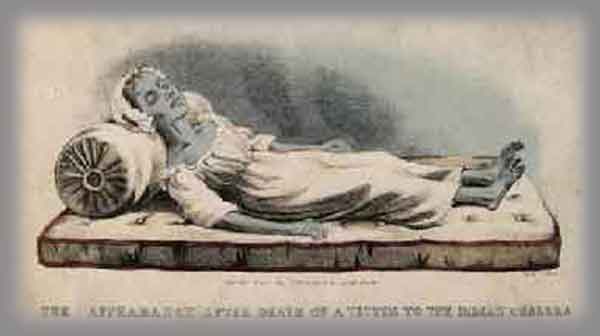
19th Century Print of a Cholera Victim
The story of the Cork Hospital Ships, is closely allied with the scourge of Asiatic Cholera. This bacterial disease is thought to have been endemic in Asia for centuries. It was as a result of empire-building, conquest, emigration and trade that the disease began to spread westwards. The symptoms of the illness were of acute diarrhrea and vomiting along with terrible muscle cramps. The most terrifying aspect of Asiatic Cholera, apart from the horrible symptoms, was the speed at which it spread. It was not unusual for a person to contract symptoms within 12 hours of exposure, with death resulting in some cases a mere 12 hours later. The mortality of Asiatic Cholera varied from 25% to 50%, a great variation, which in Ireland tended to be closer to half the sufferers losing their lives.
Initially there was great ignorance among the medical profession and authorities as to how this disease spread, and it was not until the middle of the 19th Century that it was realised that this was mainly spread by contaminated drinking water and poor sanitation. The appearence of Asiatic Cholera caused widespread panic in the countries of Europe. Not since the Bubonic Plague of the Middle Ages, had authorities, and the general population, been so aware of the spread of a disease. As the cholera swept from Russia and through Europe, steps needed to be taken to attempt to arrest it.
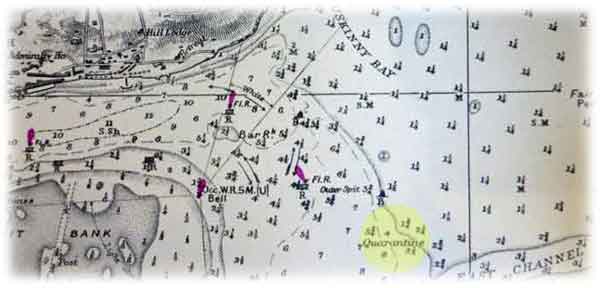
Chart of Quarantine Grounds
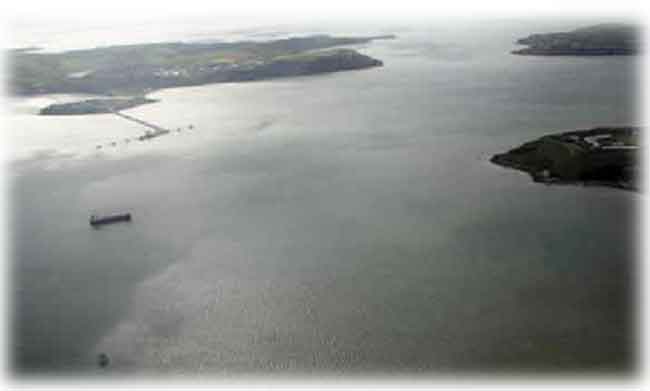
Aerial View of Quarantine Grounds
In June 1831 an order was issued directing that all vessels arriving in Cork Harbour from Russia, Prussia, and the Hanseatic towns were to proceed directly for Milford to perform Quarantine. In July, this was rescinded and ships were permitted to quarantine in Cork Harbour and Belfast. In February 1832, in Cork, the Board of Health applied to the government for the use of the convict depot, in Elizabeth Fort, as a hospital, in the event of cholera breaking out. All convicts were to be sent to the prison hulk Surprise moored in Monkstown. There were a number of counter-suggestions made, including using the Mendicity Asylum and the General Hospital in Friars Walk as cholera hospitals.
In April 1832, cholera did break out in Cork and Cove, and quickly took its toll among the poor of the city. The bishop of Cork appropriated the North Infirmary as a cholera hospital, with the surgical patients moved to the South Infirmary. At various stages of this epidemic, the hospitals in use for cholera victims were - North Infirmary Pauls Hospital Anne Street Nelson Place St Barry’s St Nicholas Downings Hospital Foundling Hospital Douglas Hospital Blackrock Hospital Glanmire (Lunatic cases were transferred to Downings Hospital) Very quickly all vessels were ordered to place their vessels in quarantine until the authorities decreed otherwise.

Elaizabth Fort, Cork City.
There was panic among the general population, and despite the pleas of the authorities and clergy, many people were too terrified to go to hospital, as they probably saw it as a death sentence. When they did attend, many were drenched in whiskey, pepper, and other quack medicines. By the end of April 1832, there had been 939 cases of cholera in Cork with 252 deaths. The military guard was removed from the convict penitentiary and the Surprise, Prison hulk, and civilian warders left in place - the military personnel were probably seen as a more valuable resource, in the event of public disorder.
By June 1832 there had been 2327 cases with 520 deaths. Within Cork, there had been cases as far afield as Kinsale Dunmanway, and Bantry. By August 1832 there had been 7900 cholera deaths in Ireland (1063 in Cork), with 8595 deaths in Britain. The Old Barracks in Barrack Street, had been designated a cholera hospital, but does not appear to have been used for this purpose. Between 1832 and 1833, 20,588 people died in Ireland from Cholera.There were sporadic Cholera outbreaks in 1834, and in 1837. The next large-scale outbreak of Cholera in Ireland, occurred in the latter part of the Irish Famine. All during the Famine there had been various fevers and dysentery, rampant due to the extreme poverty and state of squalid existence of much of the population.
Apart from emigration, there had been a large-scale flight from the land to the larger towns and cities, some of which now had the meagre relief of the workhouses. These workhouses and the crowded conditions proved a breeding ground for Cholera. It first appeared in Belfast in 1848, and rapidly spread thought the island of Ireland. The Boards of Guardians of the poor Law Commission, instituted a series of cholera sheds, in towns such as Queenstown, but these appear to have been rudimentary at best. The census of 1851 gave a figure of 30,156 deaths from Cholera in the year 1849.
In 1849 a vessel called the St John , put into Queenstown. She had a large number of emigrants on board, a number of whom were suffering from cholera. The sick were removed to the cholera shed in Queenstown, and the healthy taken to an unnamed hulk in the harbour. The ship was disinfected and later all were put aboard and the ship continued its voyage with only one loss from disease. Another ship the Pallas was only partially evacuated of the ill passengers and cleansed with the remaining on board. When the voyage was resumed, 20 passengers died of illness.
In November 1853, an emigrant ship, the Kossuth arrived in Cork Harbour. She had 600 emigrants on board, and cholera had broken out, with 21 deaths. A hulk was hired by the local health committee, and the sick were removed to it. Requests were made to the Admiralty for a hulk to be sent to Cork as a hospital ship, and that some of the empty stores on Haulbowline Island, be used for the other passengers, so that the affected ship could be fumigated. Unrelated cases of Asiatic Cholera began to appear during 1853 throughout Cork, and part of Barrack Street Hospital was fitted out as a cholera hospital. There was an application to use Cat Fort as a cholera hospital, but this was refused.
In May 1854, two emigrant vessels arrived in a distressed state. In June the Dirago arrived in harbour with the cholera raging. There was no hospital accommodation available, and the vessel had to return to Liverpool, by which time 50 passengers were dead
In 1854 Francis Maguire MP raised the necessity for a floating hospital in Cork Harbour, at the time his plea went unheeded. The main problem was not the sending of a hulk to Cork, but who was going to pay for maintaining and staffing it.
The issues were resolved, and in September 1854 HMS Inconstant (1836) a former 36 gun naval ship, arrived in Cork to serve as hospital ship. In October 1854 the ship Ben Nevis arrived from Liverpool with 445 emigrants on board. Cholera had broken out. Seven had died on passage, including the ship’s surgeon Dr Blennerhasset. Admiral Sir W. P. Carroll put the Inconstant at their disposal, and the healthy passengers were transferred to the hulk. There were no further cases on board ships the following year and the Inconstant remained idle.
In 1857 the Inconstant was used as an accommodation ship, when the Bonarges , arrived badly damaged in the harbour with 480 government emigrants. All the unmarried female emigrants were lodged on the Inconstant , while repairs were made to the Bonarges . In the same year, the passengers of another ship, the St Clair , were brought to Cork after a heroic rescue by the barque Grace and Jane . They were lodged on board the inconstant , while arrangements were made by the owners of the St Clair to arrange another ship.
In 1861, the Inconstant got a brief reprieve, being recommissioned as flagship, Queenstown, in place of the HMS Sanspareil . She was quickly replaced by HMS Hawke . By 1862,the Inconstant was seen as a hazard to navigation and the Harbour Commissioners wanted her removed. HMS Inconstant was sold to Messrs Scott, of Queenstown in Nov 1862. She was refitted and made one voyage to India as a merchantman. This was not a success, and Thomas and Philip Scott became bankrupts.
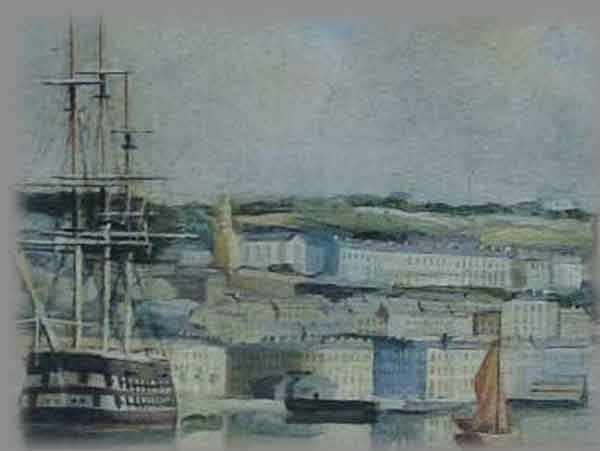
HMS Hastings
In 1866, two ships with illness on board arrived in harbour, these were the Constantine with Typhus, and Helvetia with cholera. Admiral Kerr quickly ordered that these ships must make for Liverpool, and were not allowed to land. Application was made to the authorities for a hospital ship, and also a Lazaretto for passengers not ill. The Admiralty agreed that the Queenstown flagship HMS Hastings (1819) could be used as she was being paid off. The original plan was to moor the Hastings between Aghada and East Ferry. This caused uproar among the residents of the eastern part of Cork Harbour, and deputations were sent protesting this. Eventually the Hastings was moored at the Quarantine grounds, east of the Spit Buoy.
Cholera continued to break out in Cork over the next few years, but not on an epidemic scale. The Hastings was ordered to be stripped and sold. A vessel called the Aura arrived in Cork harbour with smallpox on board, and another ship arrived with cholera.
The Hastings was unavailable, and the passengers were treated on board their respective ships. In 1869 the Admiralty offered the Hastings to the Harbour Commissioners, but on the condition that the ship would be funded locally.This was refused, and in July 1869 the Hastings was towed to Plymouth by the paddle-steamer Medusa .
In February 1871, a ship the Valkyia arrived in Cork Harbour with passengers suffering from smallpox. She was prevented in landing any passengers and the victims were treated on board. In July 1871 the ship Agusta arrived from Havana, Cuba with cases of smallpox. The ship was removed to the Quarantine ground and crew were treated. The ship was then disinfected by Dr Scott, the medical officer for Cork Port.
By 1873, a novel proposal was put to the Board of Guardians, by Mr Edward Scott, to erect a hospital structure on piles over the water, near Cove Fort. The reasoning was that the patients would be off the land, away from the local population, and ships boats could ferry the patients directly to the structure. It was also pointed out that when not in use, the hospital could be simply locked up. This plan did not progress and calls still went out for a hospital ship.
There was a scandal in 1874 when the ship Vestra arrived from Havana. The ship was in port for six days, with crew coming to and from shore, before it was discovered that she had cases of smallpox on board. She was immediately towed to the Quarantine Ground. The next cholera epidemic that threatened Cork was in 1892. The Cork Rural Health Committee applied to Admiral St John for permission to use the hulk of HMS Alarm (1845), then in the harbour, as a floating hospital. The Admiral replied that this coal hulk was unsuitable in every way and flatly refused.
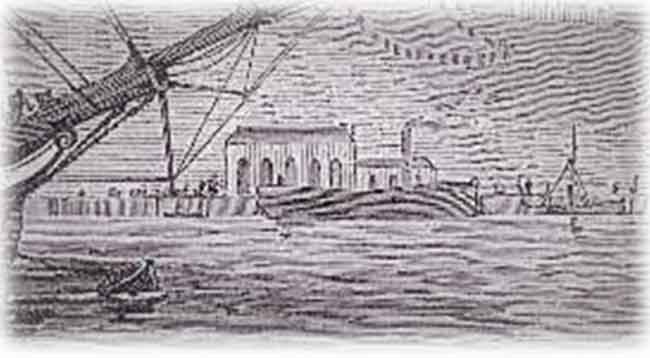
This is possibly the Coal Hulk - ex HMS Alarm
Sir Sir John Arnott, the wealthy businessman stepped in and offered to obtain a suitable vessel, including paying for it’s conversion. The Commissioners baulked at this when it was realised that maintaining the hospital ship would cost in excess of £900 a year and the plan was shelved. The subject of a hospital ship for Cork Harbour was quietly dropped. Times had moved on and increased sanitation and gradually improving living conditions meant that, cholera was not the threat it once was in Ireland. The disease is still a great danger wherever living conditions and sanitation are an issue. The next great threat to public health in Ireland, came from the great Spanish Flu pandemic, in 1918 and 1919.
